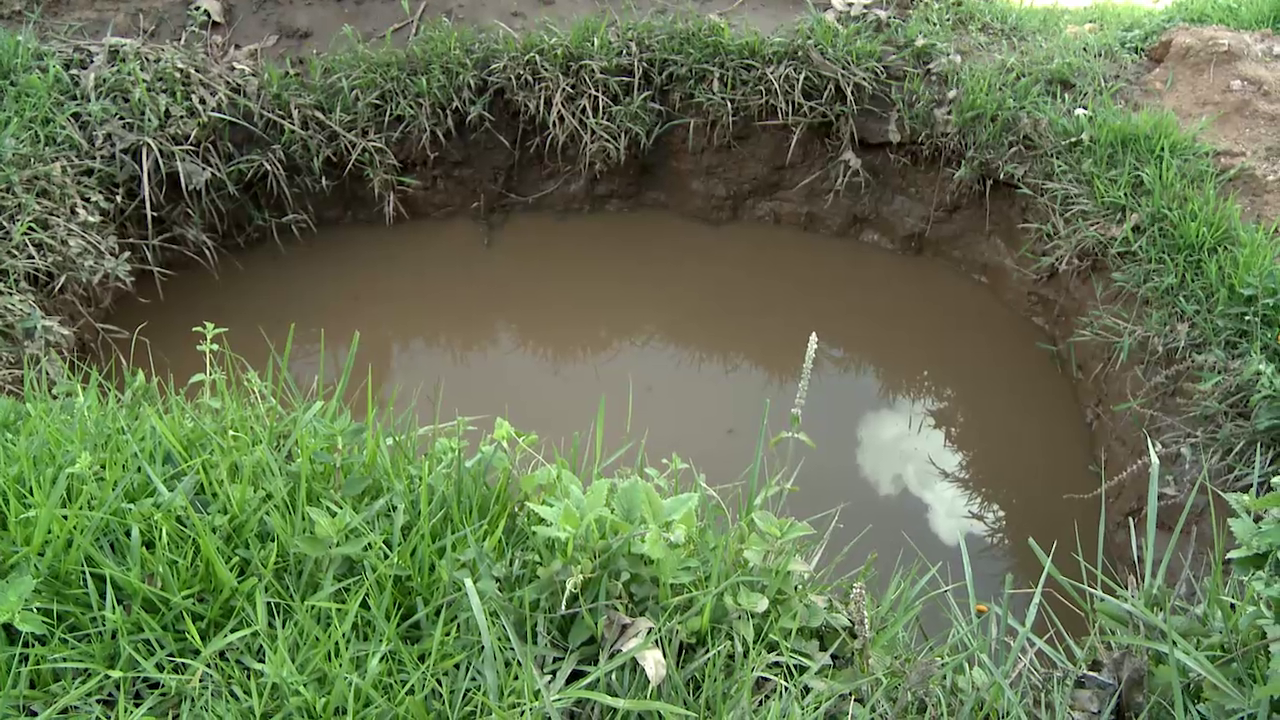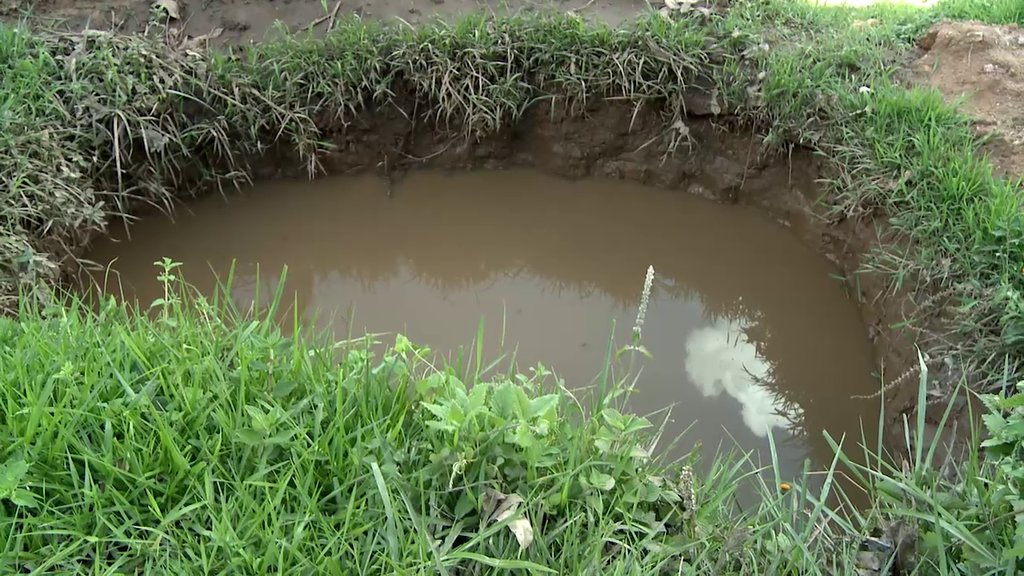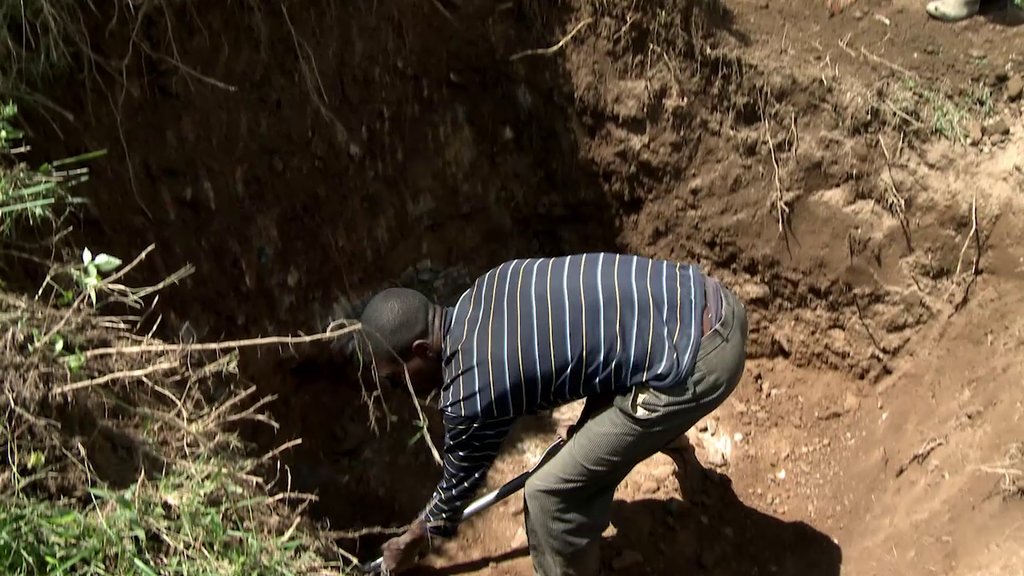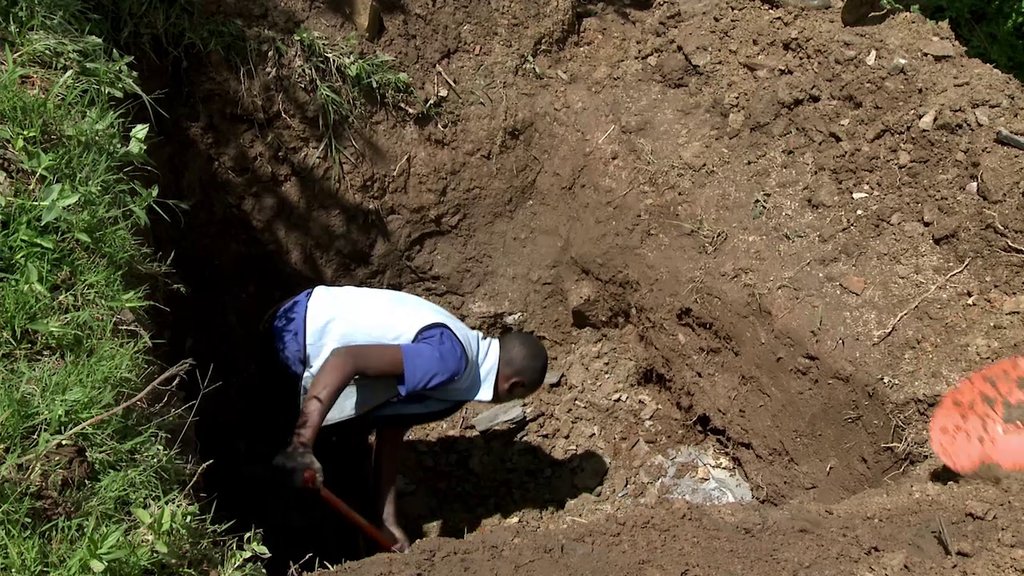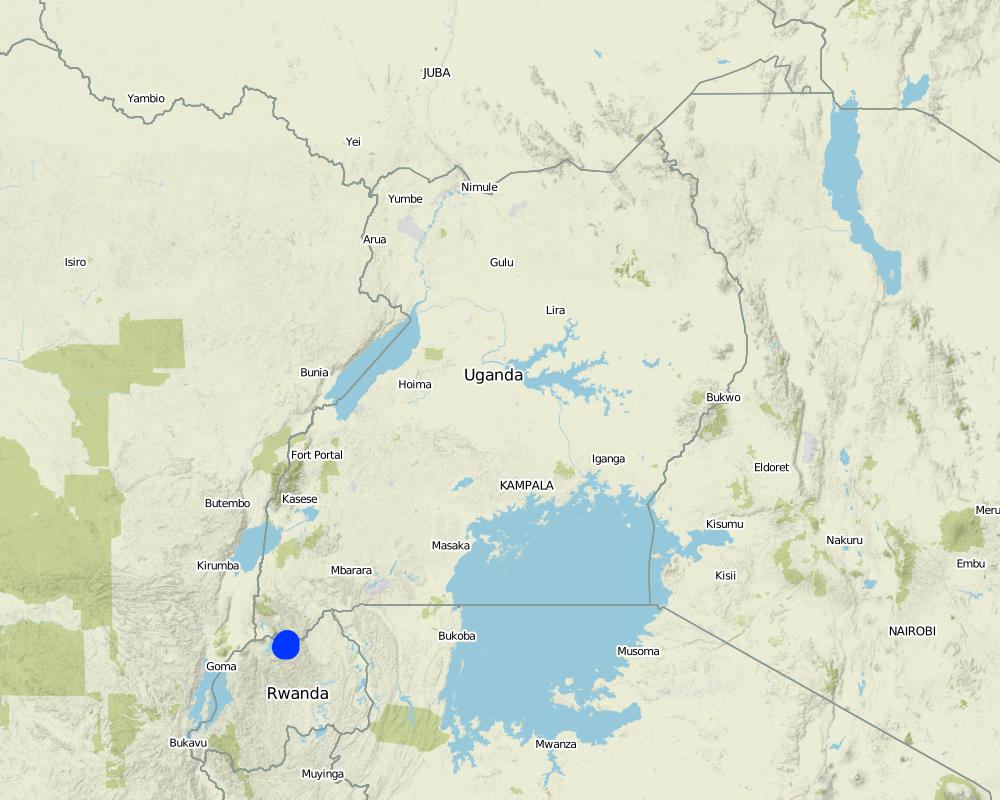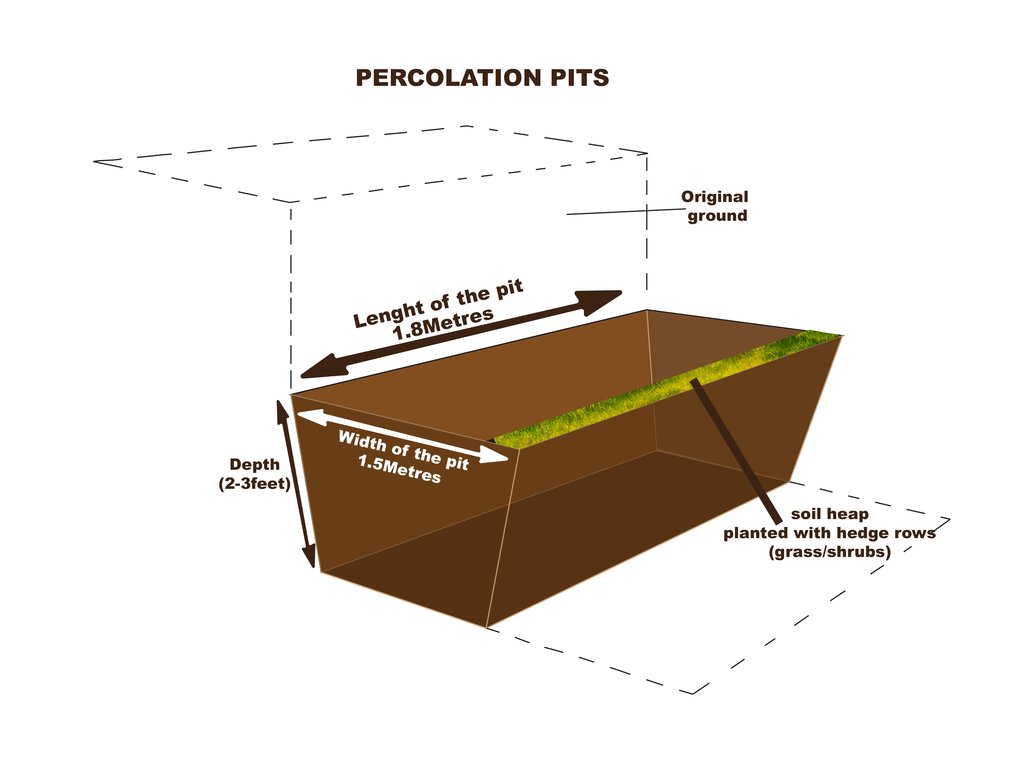Percolation pits [乌干达]
- 创建:
- 更新:
- 编制者: Philip Tibenderana
- 编辑者: –
- 审查者: Alexandra Gavilano, Nicole Harari, Hanspeter Liniger
Ebyina
technologies_619 - 乌干达
查看章节
全部展开 全部收起1. 一般信息
1.2 参与该技术评估和文件编制的资源人员和机构的联系方式
关键资源人
SLM专业人员:
有助于对技术进行记录/评估的项目名称(如相关)
Book project: where people and their land are safer - A Compendium of Good Practices in Disaster Risk Reduction (DRR) (where people and their land are safer)有助于对技术进行记录/评估的机构名称(如相关)
Tear Fund Switzerland (Tear Fund Switzerland) - 瑞士1.3 关于使用通过WOCAT记录的数据的条件
编制者和关键资源人员接受有关使用通过WOCAT记录数据的条件。:
是
1.4 所述技术的可持续性声明
这里所描述的技术在土地退化方面是否存在问题,导致无法被认为是一种可持续的土地管理技术?:
否
注释:
So far, where this technology has been applied, the water runoff has been reduced, water retention increased and soils trapped
1.5 参考关于SLM方法(使用WOCAT记录的SLM方法)的调查问卷
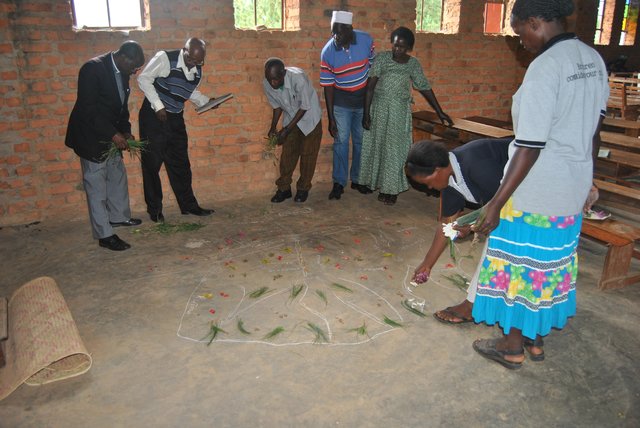
Catchment Based Integrated Water Resources Management [乌干达]
Catchment based integrated water resources management is a process which promotes the coordinated development and management of water, land and related resources in order to maximise economic and social welfare in an equitable manner without compromising the sustainability of vital eco systems
- 编制者: Philip Tibenderana
2. SLM技术的说明
2.1 技术简介
技术定义:
A percolation pit is an excavation in the ground in the pathway of water runoff to intercept the flow of the water and thereby reduce erosion and destruction of crops, settlements and other infrastructure downstream
2.2 技术的详细说明
说明:
The technology is applied in already existing degraded farmlands, which are individually owned. An average farm size is less than half an acre.
A typical percolation pit is 2m wide, 2m long and 1m deep planted with a hedge row on its lower side
This technology reduces the speed of water running down the slope during a downpour and traps the water and soil that is being washed thereby reducing soil erosion and increasing water retention
Areas which are prone to degradation by erosion are identified and later, the farmers are trained on benefits of this technology, how to construct the pit and how to maintain them by periodic de-silting and planting grasses and shrubs on the lower side
This technology helps maintain the good top soil, which would have otherwise been washed down the water course into the valley and increases water retention.
The land users like this technology because their soil is not lost by erosion. In addition it is localized, not like a conservation channel which runs along the whole contour. Percolation pits consume less land because they are located in an already existing waterway. What land users don’t like about this technology is that it has a huge sediment load and requires frequent de-silting
2.3 技术照片
2.5 已应用该技术的、本评估所涵盖的国家/地区/地点
国家:
乌干达
区域/州/省:
South Western Region
有关地点的进一步说明:
Rubaya Sub County, Kabale District
具体说明该技术的分布:
- 适用于特定场所/集中在较小区域
注释:
The technology is localised to water runoff courses which are susceptible to erosion
Map
×2.6 实施日期
注明实施年份:
2015
2.7 技术介绍
详细说明该技术是如何引入的:
- 通过土地使用者的创新
- 通过项目/外部干预
注释(项目类型等):
The technology was introduced under the Integrated Water Resources Management Project to support farmers to maximise land productivity
3. SLM技术的分类
3.1 该技术的主要目的
- 改良生产
- 减少、预防、恢复土地退化
- 保护生态系统
- 结合其他技术保护流域/下游区域
- 降低灾害风险
- 适应气候变化/极端天气及其影响
- 减缓气候变化及其影响
- 创造有益的经济影响
- 创造有益的社会影响
3.2 应用该技术的当前土地利用类型
同一土地单元内混合使用的土地::
是
具体说明混合土地使用(作物/放牧/树木):
- 农林业

农田
每年的生长季节数:
- 2
具体说明:
September to January and March to June

牧场
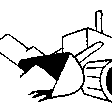
矿山、采掘业
3.4 供水
该技术所应用土地的供水:
- 雨养
3.5 该技术所属的SLM组
- 集水
- 引水和排水
- 地下水管理
3.6 包含该技术的可持续土地管理措施

植物措施
- V1:乔木和灌木覆盖层
- V2:草和多年生草本植物

结构措施
- S3:分级沟渠、渠道、水道
3.7 该技术强调的主要土地退化类型

土壤水蚀
- Wt:表土流失/地表侵蚀
- Wg:冲沟侵蚀/沟蚀
- Wm:块体运动/滑坡
3.8 防止、减少或恢复土地退化
具体数量名该技术与土地退化有关的目标:
- 减少土地退化
4. 技术规范、实施活动、投入和成本
4.1 该技术的技术图纸
技术规范(与技术图纸相关):
Dimensions indicated on drawing above
作者:
Kigezi Diocese Water and Sanitation Programme
日期:
12/12/2016
4.2 有关投入和成本计算的一般信息
具体说明成本和投入是如何计算的:
- 每个技术单元
指定单位:
Per pit
指定单位面积(如相关):
4 cubic meters
具体说明成本计算所用货币:
- 美元
如相关,注明美元与当地货币的汇率(例如1美元=79.9巴西雷亚尔):1美元=:
3300.0
注明雇用劳工的每日平均工资成本:
USD 2.12
4.3 技术建立活动
| 活动 | 时间(季度) | |
|---|---|---|
| 1. | Excavation of the percolation pit | During the dry season |
| 2. | Planting hedge rows | Onset of rains |
4.4 技术建立所需要的费用和投入
| 对投入进行具体说明 | 单位 | 数量 | 单位成本 | 每项投入的总成本 | 土地使用者承担的成本% | |
|---|---|---|---|---|---|---|
| 劳动力 | Excavation of pit | person days | 4.0 | 2.12 | 8.48 | 100.0 |
| 设备 | Forked hoes (1 piece can excavate 50 pits) | pieces | 0.02 | 4.55 | 0.09 | |
| 设备 | Pick axes (1 piece can excavate 50 pits) | pieces | 0.02 | 4.55 | 0.09 | |
| 设备 | Spades (1 piece can be used on 50 pits) | pieces | 0.02 | 4.55 | 0.09 | |
| 植物材料 | Starria grass (1 sack for 5 pits) | per pit | 1.0 | 1.21 | 1.21 | |
| 技术建立所需总成本 | 9.96 | |||||
如果土地使用者负担的费用少于100%,请注明由谁负担其余费用:
Kigezi Diocese Water and Sanitation Programme
注释:
The land users excavate the pis themselves but the tools are beyond the financial capacity of the land user hence the need for subsidy
4.5 维护/经常性活动
| 活动 | 时间/频率 | |
|---|---|---|
| 1. | De-silting the pits | When half full |
| 2. | Maintenance of the hedge rows by triming and replanting empty spaces | Continous |
4.6 维护/经常性活动所需要的费用和投入(每年)
| 对投入进行具体说明 | 单位 | 数量 | 单位成本 | 每项投入的总成本 | 土地使用者承担的成本% | |
|---|---|---|---|---|---|---|
| 劳动力 | Desilting the pits when half full | person days | 1.0 | 2.12 | 2.12 | 100.0 |
| 劳动力 | Trimming of hedge rows (on 25 pits per day) | person days | 0.04 | 2.12 | 0.08 | |
| 技术维护所需总成本 | 2.2 | |||||
如果土地使用者负担的费用少于100%,请注明由谁负担其余费用:
N/A
注释:
The initial investment of the equipment is adequate for maintenance at least for some years
4.7 影响成本的最重要因素
描述影响成本的最决定性因素:
The costs have been calculated basing on depth of top soil of 51 – 80cm. When the depth of the top soil is shallow, then the costs of breaking the underlying sub-surface layers, which are usually rock, are much higher. Also during the rainy season, the soil is more workable
The costs of maintenance will be less where the rest of the landscape also has other percolation pits, conservation channels, good vegetative cover and where the hill slope is gentle.
5. 自然和人文环境
5.1 气候
年降雨量
- < 250毫米
- 251-500毫米
- 501-750毫米
- 751-1,000毫米
- 1,001-1,500毫米
- 1,501-2,000毫米
- 2,001-3,000毫米
- 3,001-4,000毫米
- > 4,000毫米
指定年平均降雨量(若已知),单位为mm:
1200.00
有关降雨的规范/注释:
Bi-modal rainfall pattern with long rainy season from September to December then March to May
注明所考虑的参考气象站名称:
Kabale District Meterological Department
农业气候带
- 半湿润
5.2 地形
平均坡度:
- 水平(0-2%)
- 缓降(3-5%)
- 平缓(6-10%)
- 滚坡(11-15%)
- 崎岖(16-30%)
- 陡峭(31-60%)
- 非常陡峭(>60%)
地形:
- 高原/平原
- 山脊
- 山坡
- 山地斜坡
- 麓坡
- 谷底
垂直分布带:
- 0-100 m a.s.l.
- 101-500 m a.s.l.
- 501-1,000 m a.s.l.
- 1,001-1,500 m a.s.l.
- 1,501-2,000 m a.s.l.
- 2,001-2,500 m a.s.l.
- 2,501-3,000 m a.s.l.
- 3,001-4,000 m a.s.l.
- > 4,000 m a.s.l.
说明该技术是否专门应用于:
- 不相关
5.3 土壤
平均土层深度:
- 非常浅(0-20厘米)
- 浅(21-50厘米)
- 中等深度(51-80厘米)
- 深(81-120厘米)
- 非常深(> 120厘米)
土壤质地(表土):
- 中粒(壤土、粉土)
土壤质地(地表以下> 20厘米):
- 中粒(壤土、粉土)
表土有机质:
- 中(1-3%)
5.4 水资源可用性和质量
地下水位表:
> 50米
地表水的可用性:
好
水质(未处理):
不良饮用水(需要处理)
水的盐度有问题吗?:
否
该区域正在发生洪水吗?:
是
规律性:
偶然
关于水质和水量的注释和进一步规范:
Water quantity and quality is dependent on human activities and rainfall patterns.
5.5 生物多样性
物种多样性:
- 中等
栖息地多样性:
- 中等
5.6 应用该技术的土地使用者的特征
定栖或游牧:
- 定栖的
生产系统的市场定位:
- 生计(自给)
- 混合(生计/商业)
非农收入:
- 低于全部收入的10%
相对财富水平:
- 贫瘠
个人或集体:
- 个人/家庭
机械化水平:
- 手工作业
性别:
- 男人
土地使用者的年龄:
- 青年人
- 中年人
5.7 应用该技术的土地使用者使用的平均土地面积
- < 0.5 公顷
- 0.5-1 公顷
- 1-2 公顷
- 2-5公顷
- 5-15公顷
- 15-50公顷
- 50-100公顷
- 100-500公顷
- 500-1,000公顷
- 1,000-10,000公顷
- > 10,000公顷
这被认为是小规模、中规模还是大规模的(参照当地实际情况)?:
- 小规模的
5.8 土地所有权、土地使用权和水使用权
土地所有权:
- 个人,未命名
土地使用权:
- 个人
用水权:
- 社区(有组织)
5.9 进入服务和基础设施的通道
健康:
- 贫瘠
- 适度的
- 好
教育:
- 贫瘠
- 适度的
- 好
技术援助:
- 贫瘠
- 适度的
- 好
就业(例如非农):
- 贫瘠
- 适度的
- 好
市场:
- 贫瘠
- 适度的
- 好
能源:
- 贫瘠
- 适度的
- 好
道路和交通:
- 贫瘠
- 适度的
- 好
饮用水和卫生设施:
- 贫瘠
- 适度的
- 好
金融服务:
- 贫瘠
- 适度的
- 好
6. 影响和结论性说明
6.1 该技术的现场影响
社会经济效应
生产
作物生产
注释/具体说明:
The impacts are visible even after the first crop
作物质量
饲料生产
饲料质量
生产故障风险
产品多样性
生产区域
土地管理
收入和成本
农业投入费用
农业收入
收入来源的多样性
工作量
社会文化影响
食品安全/自给自足
注释/具体说明:
It is expected to improve in the long term
健康状况
社区机构
SLM/土地退化知识
冲突缓解
生态影响
水循环/径流
地表径流
地下水位/含水层
注释/具体说明:
Recharge is hoped to increase in the long term as more farmers adapt the technology
土壤
土壤水分
土壤覆盖层
土壤流失
土壤堆积
土壤有机物/地下C
注释/具体说明:
By use of manure
减少气候和灾害风险
洪水影响
注释/具体说明:
Flooding in the valley bottoms due to runoff reduces significantly
6.2 该技术的场外影响已经显现
水资源可用性
注释/具体说明:
As more people adopt the technology this is expected to increase
下游洪水
对邻近农田的破坏
注释/具体说明:
The runoff which causes damage is trapped in the percolation pits
对公共/私人基础设施的破坏
注释/具体说明:
Especially on roads and water systems
6.3 技术对渐变气候以及与气候相关的极端情况/灾害的暴露和敏感性(土地使用者认为的极端情况/灾害)
渐变气候
渐变气候
| 季节 | 增加或减少 | 该技术是如何应对的? | |
|---|---|---|---|
| 年温度 | 增加 | 未知 | |
| 季节性温度 | 湿季/雨季 | 增加 | 未知 |
| 季节性温度 | 旱季 | 增加 | 未知 |
| 年降雨量 | 减少 | 未知 | |
| 季雨量 | 湿季/雨季 | 减少 | 未知 |
气候有关的极端情况(灾害)
气象灾害
| 该技术是如何应对的? | |
|---|---|
| 局地暴雨 | 好 |
| 局地雷暴 | 好 |
| 局地雹灾 | 好 |
气候灾害
| 该技术是如何应对的? | |
|---|---|
| 陆地火灾 | 好 |
水文灾害
| 该技术是如何应对的? | |
|---|---|
| 比较和缓的(河道)洪水 | 非常好 |
| 山洪暴发 | 非常好 |
| 滑坡 | 好 |
6.4 成本效益分析
技术收益与技术建立成本相比如何(从土地使用者的角度看)?
短期回报:
积极
长期回报:
非常积极
技术收益与技术维护成本/经常性成本相比如何(从土地使用者的角度看)?
短期回报:
积极
长期回报:
非常积极
6.5 技术采用
- 单例/实验
在所有采用这项技术的人当中,有多少人是自发的,即未获得任何物质奖励/付款?:
- 91-100%
注释:
The adoption rate of this technology is gradual as people keep appreciating the benefits
6.6 适应
最近是否对该技术进行了修改以适应不断变化的条件?:
否
6.7 该技术的优点/长处/机会
| 土地使用者眼中的长处/优势/机会 |
|---|
| It controls soil loss from the land users gardens |
| It provides silt which is spread in their garden |
| Hedge rows are used as fodder and as mulching material |
| The conserved water is used to benefit the plants in the same garden |
| 编制者或其他关键资源人员认为的长处/优势/机会 |
|---|
| The percolation pits prevent development of gullies |
| It improves water percolation in the soil which increases soil moisture content and increases ground water recharge |
| They prevent silt deposition in the valley bottoms and siltation of water bodies |
| It is a simple technology which uses simple hand tools |
6.8 技术的弱点/缺点/风险及其克服方法
| 土地使用者认为的弱点/缺点/风险 | 如何克服它们? |
|---|---|
| This technology requires a lot of hard labour | The land users were encouraged to form small groups which work together to ease the work and share knowledge and skill |
| 编制者或其他关键资源人员认为的弱点/缺点/风险 | 如何克服它们? |
|---|---|
| This technology is dependent on land users continued efforts in de-silting it. When this is not done the technology fails | Land users are encouraged to periodically de-silt the pits |
| The effectiveness of this technology is dependent on the compliance of other land users in the landscape. For example if it is done downhill and not uphill, then the pits will be overwhelmed by the volume of the soil and water runoff | All community members were sensitised on the importance and effectiveness of this technology and existing by-laws will foster members uphill to practice the technology. The benefits of the technology will encourage other land users to adopt it |
| The process of maintaining and rolling out this technology requires engagement of many stakeholders | Management structures, which are well linked with government structures, have been set up and trained at various levels to manage the process of maintaining and rolling out the technology |
7. 参考和链接
7.1 信息的方法/来源
- 实地考察、实地调查
Observation field visits to percolation pit sites
- 与土地使用者的访谈
Focus group discussion with 18 land users
- 与SLM专业人员/专家的访谈
Programme implementation team
- 根据报告和其他现有文档进行编译
Programme progress reports
(现场)数据是什么时候汇编的?:
07/09/2016
7.2 参考可用出版物
标题、作者、年份、ISBN:
Kigezi Diocese Water and Sanitation Programme, IWRM Annual Report (April 2015 - March 2016)
可以从哪里获得?成本如何?
www.kigezi-watsan.ug
标题、作者、年份、ISBN:
IWRM Pilot report 2013
可以从哪里获得?成本如何?
www.kigezi-watsan.ug
7.3 链接到网络上的相关信息
标题/说明:
Test pits
URL:
http://gamarch.co.uk/?page_id=966
标题/说明:
Percolation test pits
URL:
http://www.mfkelly.ie/percolation_tests.asp
链接和模块
全部展开 全部收起链接

Catchment Based Integrated Water Resources Management [乌干达]
Catchment based integrated water resources management is a process which promotes the coordinated development and management of water, land and related resources in order to maximise economic and social welfare in an equitable manner without compromising the sustainability of vital eco systems
- 编制者: Philip Tibenderana
模块
无模块


